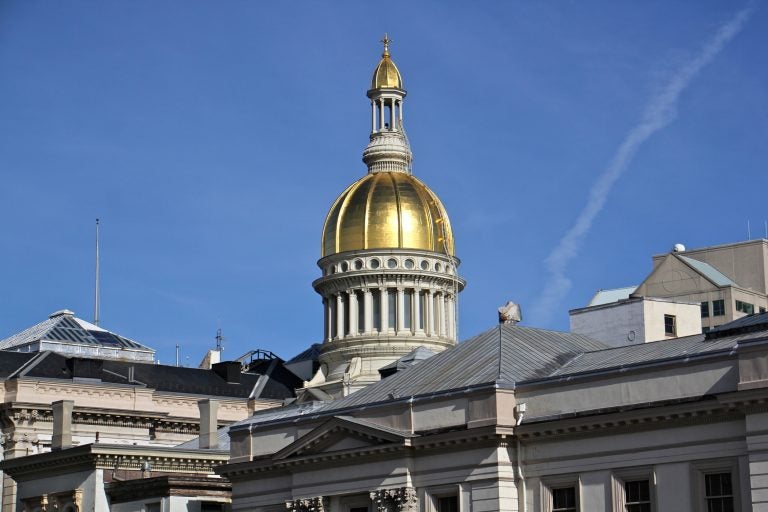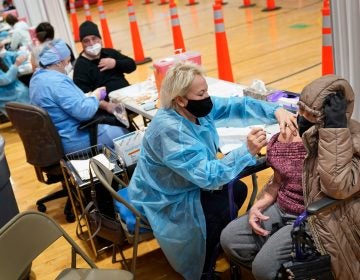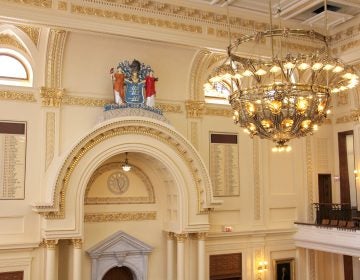Most people are filling out the census, just not those N.J. says most need to be counted
Low response rates in communities of color could mean the loss of federal funds.

New Jersey Statehouse in Trenton. (Emma Lee/WHYY)
This story originally appeared on NJ Spotlight.
___
Two weeks before census takers begin fanning out across New Jersey trying to count individuals who have yet to complete the decennial survey, the state’s response rate of nearly 65% exceeds the national average.
But behind that average is an uneven response rate that could lead to undercounts of Black and Hispanic residents, immigrants and others. And as a result, New Jersey may not get its fair share of federal funding for a host of programs, and minority groups could find themselves underrepresented in the state Legislature and in Congress.
“The risk of failing to count these areas is dire for New Jersey,” said Peter Chen, policy counsel for Advocates for Children of New Jersey (ACNJ), which is coordinating the census efforts of a number of groups and nonprofits in New Jersey. “Much of New Jersey’s remaining Census count is households in low-response areas, and an undercount could be disastrous for funding for anti-poverty programs, school and education funding and political representation at the state and federal levels.”
The differences in response rates in some census tracts — geographic areas of about 4,000 people that generally follow neighborhood and municipal boundaries — are striking.
The tract with the highest response rate is number 195 in Maplewood, where almost 89% of households had completed the census as of Monday, according to the Hard to Count map project of the CUNY Center for Urban Research. Its population was about 5% Hispanic and 10% Black, according to the 2018 U.S. Census American Community Survey, with no households having limited proficiency in English, less than 1% living in poverty and only 1% lacking internet access.
In Tract 121 in Irvington, which borders Maplewood, fewer than 36% had answered the survey. The population there was 22% Hispanic and 73% Black, with about 18% limited in English proficiency, nearly 17% living in poverty and 31% of households without online access.
“The areas with response rates higher than the state average have populations that are on average more white, higher-income, more likely to speak English fluently, and more likely to have Internet access,” Chen said. “Areas with lower-than-statewide response rates have higher percentages of Black and Hispanic residents and a substantially higher poverty rate and low-income resident rate with almost 20% of residents lacking internet access.”
Local complete-count committees formed to promote the census and organizations throughout the state spent months devising strategies and plans for engaging residents of areas with low response rates in past surveys, known as hard-to-count areas. The state provided some $5.2 million to community groups and counties for their efforts.
Impact of the pandemic
But no one planned on COVID-19’s devastating impact on New Jersey. The pandemic hit in early March, shortly before residents began receiving letters telling them how to respond to what is a largely online survey for the first time in census history. While the worst of the initial wave in the state ended more than a month ago, New Jersey continues under a state of emergency, with restrictions on gatherings, and hundreds are testing positive for the novel coronavirus every day.
“We always knew we were going to have a hard time with the undocumented, who fear the government and deportation,” said Rosa Lopez Huitzitzilin of the immigrant advocacy group Make the Road New Jersey. “We trained a group of Census ambassadors who could talk about how safe the Census is. We had success with that. We were planning on hosting events where these women would go and talk about the Census. But once COVID got here, it hit the community really hard.”
She noted that many people have been “in survival mode” and focused on the virus for a long time and that made it harder to even try to talk about a population count.
“There was a point where we couldn’t even mention the Census; we didn’t want to be insensitive, with people in the hospital or passing away,” Huitzitzilin continued. “Now it feels a little more OK to be pushing forward.”
There were going to be rallies and small group meetings, pitches at church services and door-to-door canvassing, kiosks and computer tablets where those without internet access could fill out the survey. COVID-19 drove most events online to Facebook, Zoom and other livestreams.
“We’ve been doing a lot of online organizing,” Huitzitzilin said, adding that the group has been using such social media platforms as TikTok and Instagram to try to target younger individuals who often fill out forms for parents with limited English skills.
To find a municipality, zoom in and move the map or click on the magnifying glass to use the search box. Click on a location for details. Source: US Census Bureau.
In many hard-to-count areas, virtual events have not been enough to motivate people to complete the census. On average, in underperforming tracts, barely more than half of households had answered the survey, and the average response rate for those areas was about 8.5 percentage points behind 2010.
“At the end of the day, though, this ‘Get out the Count’ component of Census outreach relies on in-person and on-the-ground neighborhood and community outreach,” Chen said. “Most folks who were easy to reach or persuade to complete the questionnaire have already done so. And with the restrictions of COVID-19, in-person canvassing and events have more obstacles than they would have otherwise. And the kinds of sites where people might have congregated regularly — schools, libraries, churches, pools/playgrounds — are either closed or seeing reduced usage.”
‘Push week’
Some organizations have shifted gears, with several dozen hosting different events this week — designated “push week” by the U.S. Census Bureau as a last push for self-response before sending enumerators out to knock on doors.
In some locations, people will be able to pick up food or hand sanitizer and complete the census. Others will provide ice cream vouchers to those who fill out the survey. Organizations are combining census completion with events marking Black Lives Matter and honoring first responders.
Several locations will have kiosks or mobile devices to make answering the survey quicker and easier. And in places like Elizabeth, Jersey City and Orange, volunteers are planning to go to housing developments and areas with low response rates in the past to try to persuade residents to be counted.
Chen said recent activities in Newark that combined the census with COVID-19 testing were particularly effective, boosting the city’s response by about 3,000 since last week.
But there’s not much money left for census-specific activities.
“The original $9 million budget appropriation did not anticipate a pandemic or extended Census window, meaning that many organizations that received funding and the state’s own media campaign did not budget for the extended window,” Chen said. “As I understand it, some had already exhausted their grant budget by the time the pandemic hit.”
Advocates say at this point the state is not likely to lose a congressional representative — as it did in 2010. But the apportionment of the state Legislature will hinge on the count, and shifts in population from suburbs to cities or back to the suburbs, and the racial and ethnic makeup of areas, will in part dictate how legislative district boundaries are drawn.
Impact on federal aid
The allocation of federal aid is another reason why officials want everyone counted, particularly in light of the pandemic. Billions in funding from the CARES Act, the largest federal stimulus package this year, were allocated based on population. This includes aid for dislocated workers, food assistance, and services for senior citizens and the disabled, as well as general pandemic response funding.
A study released earlier this year estimated that New Jersey got $45.8 billion in census-guided federal funding in fiscal 2017, the ninth highest allocation in the nation. Medicaid and Medicare are the largest beneficiaries, but there are more than 300 programs in all that cover a broad range of needs.
Advocates got extra motivation last week with the announcement by the White House of a memorandum that seeks to exclude the undocumented from the population counts used for congressional reapportionment.
“The rhetoric coming up from Washington is not just wrong, it’s contrary to the spirit of our Constitution,” Gov. Phil Murphy said last Friday as he provided an update on the census during a media briefing on COVID-19. “And it is unenforceable.”
“The United States Constitution requires a full count of all people living in America, not just those the president believes belong here,” said Assemblywoman Angelica Jimenez (D-Hudson). “The notion to exclude undocumented individuals is preposterous and a xenophobic effort to sideline, again, a culture and community whose significant growth and contributions has helped to redefine this nation. This is another attempt to instill fear in the Latino Community and throw off the Census count … We need to concentrate on getting a full, complete count more than ever now.”
New Jersey had planned a $3 million advertising campaign to boost participation in hard-to-count areas, but it is unclear how much the state has done. A spokeswoman for Secretary of State Tahesha Way, who is heading Trenton’s census efforts, did not respond to a question about the state’s current efforts beyond using social media.
“I think the state is doing what it can at this late hour to boost response rates,” Chen said. “The reality is that response rate has plateaued nationally.”

Get daily updates from WHYY News!
WHYY is your source for fact-based, in-depth journalism and information. As a nonprofit organization, we rely on financial support from readers like you. Please give today.





